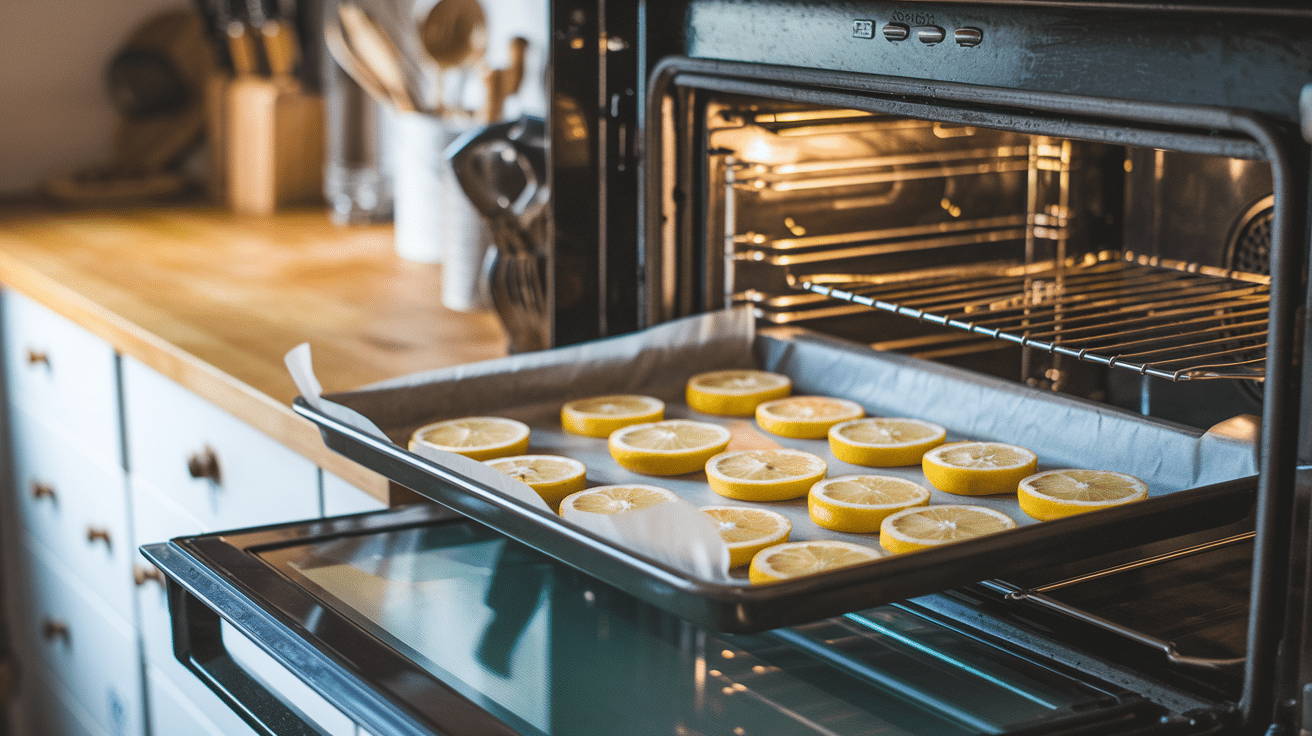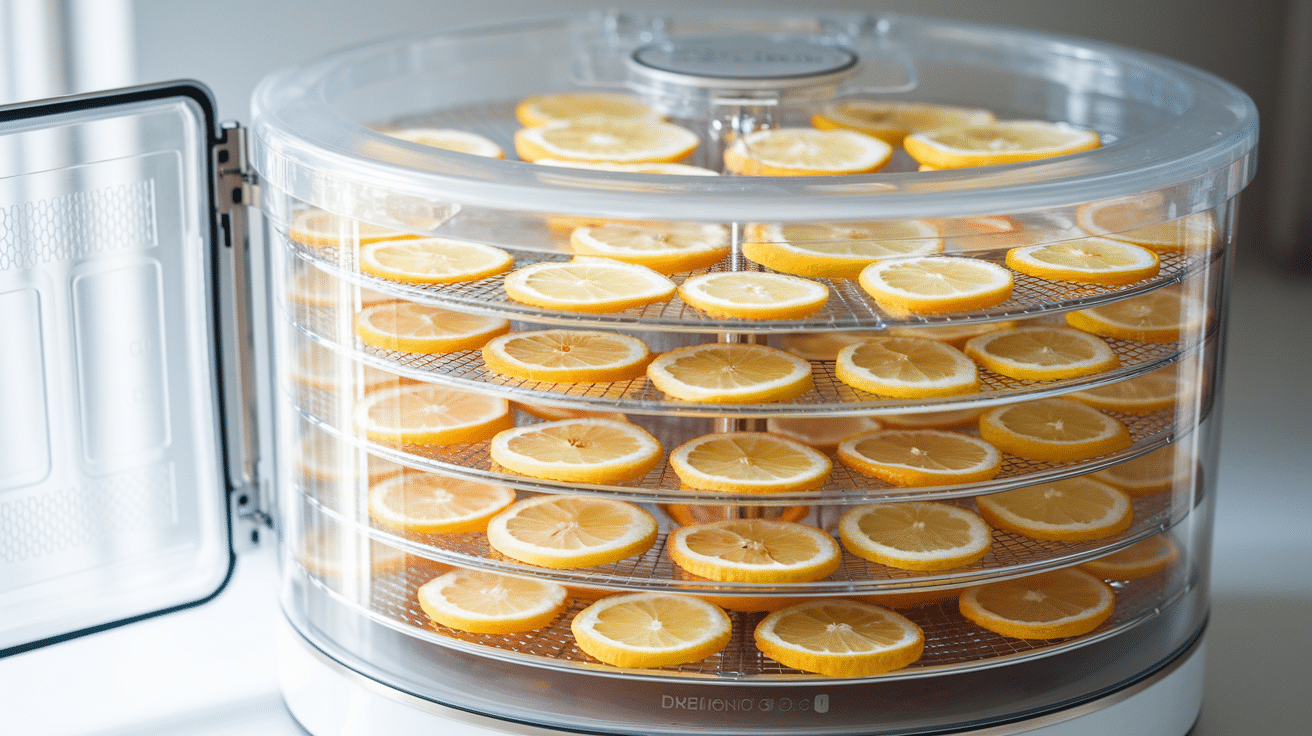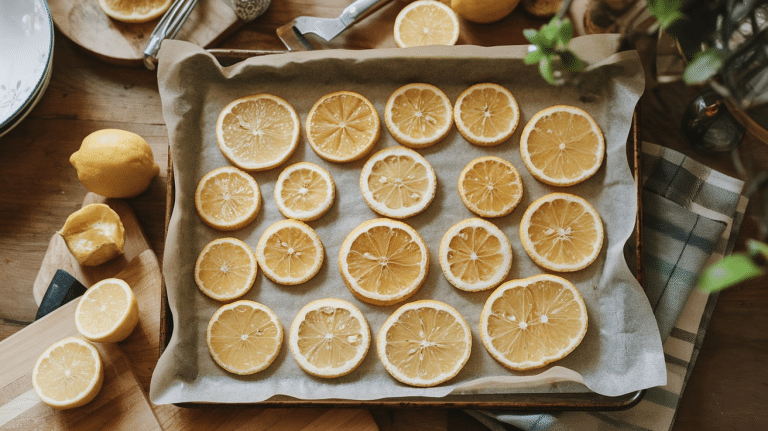Ever noticed how beautiful those dried citrus wheels look in holiday decorations or fancy drinks? They’re not just pretty—they’re practical too!
Drying citrus at home is a simple project that anyone can try, and it’s a great way to use up extra lemons, oranges, or other citrus fruits before they go bad.
The nice thing about dried citrus is how useful it becomes. You can add it to hot tea, use it as a natural decoration, or include it in recipes for an extra pop of flavor. Plus, the process fills your home with amazing citrus scents while you work.
In this guide, you’ll learn three easy ways to dry citrus at home, along with tips to help you get great results every time.
Why Dehydrate Lemons?
Drying citrus helps you make the most of these fruits in several ways:
First, it extends their shelf life significantly. When properly dried and stored, citrus can last for months instead of days.
It’s also a great seasonal activity when citrus fruits are plentiful and affordable. By drying them, you can enjoy their flavor and beauty throughout the year.
Dried citrus adds concentrated flavor without adding moisture to recipes, making it perfect for teas, baked goods, and cocktails.
Best Citrus Fruits for Drying
While you can dry almost any citrus fruit, some varieties work better than others:
- Lemons: With their bright acidity, dried lemons work well in both sweet and savory dishes.
- Limes: These add a sharp, tangy note to drinks and foods when dried.
- Oranges: Navel oranges dry beautifully with their natural sweetness. Blood oranges create stunning deep red slices, while Cara Cara oranges offer a pink-tinged alternative.
- Grapefruit: Though larger and requiring more drying time, their mild bitterness makes them interesting additions to culinary creations.
- Mandarins and satsumas: These smaller citrus fruits dry quickly and offer a sweet flavor profile.
Supplies You’ll Need
The process of drying citrus at home is straightforward and needs only a handful of simple items from your kitchen.
You need a sharp knife or mandoline slicer on hand to cut your fruit into pieces of equal thickness, which helps them dry at the same rate.
For the actual drying, you can use either your regular home oven or a food dehydrator if you have one available.
To prepare for oven drying, gather some baking sheets and either line them with parchment paper or use wire racks placed on top for better air flow.
Once your citrus is completely dry, you’ll need clean, airtight containers to keep your finished product fresh and usable for months to come.
With these basic tools, you can easily transform fresh citrus into long-lasting dried versions for cooking, drinks, or decorations.
Methods to Dehydrate Lemons
The process of drying citrus is a simple and useful skill that lets you preserve seasonal fruits for year-round use.
Dried citrus adds bright flavor to foods and drinks while also making beautiful decorations for your home. With just a few basic kitchen tools and some patience, you can turn ordinary lemons, oranges, and other citrus into long-lasting, versatile ingredients.
The methods are easy to learn, making this a perfect weekend project during citrus season.
1. The Oven Method

The oven method is accessible for most home cooks:
Step 1: Preheat oven to 170°F-200°F.
Step 2: Wash citrus fruits and cut into 1/8″-1/4″ thick slices.
Step 3: Place slices on a wire rack or parchment-lined baking sheet without overlapping.
Step 4: Bake for the right time (lemons/limes: 3-4 hours, oranges: 4-5 hours, grapefruit: 5-6 hours).
Step 5: Flip slices halfway through and rotate trays as needed.
Step 6: Test for doneness – slices should feel dry but slightly pliable.
2. Using a Dehydrator

A food dehydrator offers more consistent results:
Step 1: Slice your citrus fruits to 1/8″ to 1/4″ thickness after washing and drying them.
Step 2: Arrange slices in a single layer on dehydrator trays, leaving space between each slice.
Step 3: Set your dehydrator to approximately 122°F.
Step 4: Dry for about 12-15 hours, checking occasionally. Thinner slices dry faster.
Step 5: The citrus is ready when it feels dry to the touch with no sticky or wet spots.
Step 6: Allow to cool completely before storing.
3. Air-Dry Citrus Naturally

For the no electricity method:
Step 1: Cut citrus fruits into thin, even slices.
Step 2: Thread string through each slice and hang them in a warm, dry spot with good air flow.
Step 3: Keep away from direct sunlight and choose a low-humidity area.
Step 4: Allow 1-2 weeks for complete drying based on your climate and slice thickness.
Step 5: Check often for mold signs, which indicate too much moisture in the air.
When drying citrus, there are several basic errors that can affect your results.
- Cutting fruit slices too thick makes them take longer to dry and increases the chance of mold growth.
- Not turning the slices during the drying process often leads to uneven results, with some parts dried and others still moist.
- Taking the citrus out of the oven or dehydrator too early is risky as moisture left inside can cause spoilage later.
- Applying oil to your trays or pans is another mistake that leaves the dried fruit with a sticky texture.
- Finally, storing your dried citrus in ways that allow moisture to reach it will undo all your hard work
How to Store Dried Citrus
Proper storage keeps your dried citrus usable for longer:
-
Make sure the citrus is completely cool and dry before storing.
-
Glass jars with tight-fitting lids work best for storage. You can also use airtight plastic containers or bags.
-
For best quality, store in a cool, dark place like a pantry.
-
For longer preservation, you can keep them in the refrigerator.
-
For eating purposes, dried citrus typically stays good for 6-12 months. For decorative use, they can last much longer.
Creative Ways to Use Dried Citrus
Dried citrus is an amazingly flexible addition to your kitchen and home. Try adding a bright slice to your favorite mixed drinks for both visual appeal and subtle flavor.
When baking, dried citrus works wonderfully between cake layers, adding both color and a hint of tanginess to each bite.
For tea lovers, dropping a piece into your cup brings a fresh citrus note to both hot and cold brews.
You can also create citrus-flavored sugar by burying the dried slices in a container of sugar for a week or two.
During holidays, dried citrus make simple yet beautiful decorations for your home when strung together.
For a quick sweet treat, try dipping half of each dried slice in melted chocolate for a tasty contrast of flavors.
Don’t forget about the peels – they can be ground into a fine powder to add to your spice mixes or baking recipes.
These simple ideas help you make the most of your dried citrus, turning this easy home project into useful ingredients and decorations you can enjoy all year long.
Conclusion
Drying citrus at home is a simple skill that brings so many benefits. We’ve gone through all the steps – from picking the right fruits to slicing them just right, and then drying them using your oven, a dehydrator, or even the open air.
The best part? Once you’ve made your first batch of dried citrus, you’ll find countless ways to use it.
From jazzing up drinks to adding zest to baked goods or making your home look good, these colorful slices are truly useful.
Try it out the next time you have extra lemons or oranges sitting around. It’s not complicated, doesn’t need fancy equipment, and gives you something that lasts for months.
That’s the beauty of this simple kitchen project – big rewards with very little fuss.













